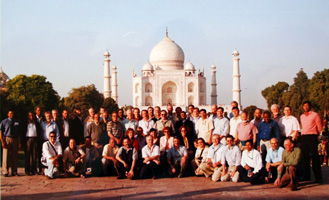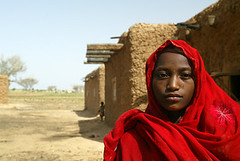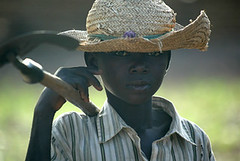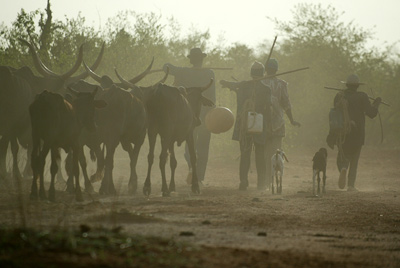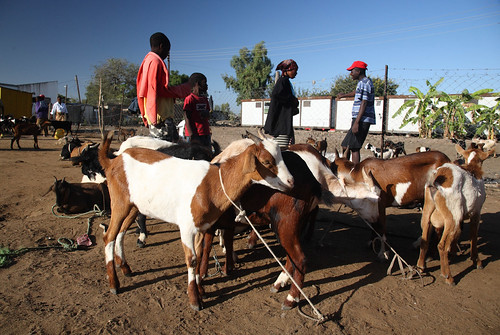| A major new report launched today charts a pathway towards the effective control of foot-and-mouth disease (FMD) in developing countries where the disease is a serious and growing threat. | |
|
The report, ‘Global Road Map for Improving the Tools to Control Foot-and-Mouth Disease in Endemic Settings’, launched today (17 April 2007) at the headquarters of the United Nations Food and Agriculture Organization (FAO), in Rome, envisions ‘a world in which livestock-based livelihoods, enterprises and trade can flourish unimpeded by FMD’. The road map focuses on the outputs of a workshop held in Agra, India, in December 2006.
Efficacious vaccines, strategically deployed, have revolutionized control of many infectious human and animal diseases. For FMD, which severely constrains the welfare of millions of small-scale livestock farmers in the developing world, currently available vaccines do not meet many of the basic requirements necessary for sustainable control. FMD continues to be a persistent constraint to livestock production throughout the developing world. It can significantly reduce production of milk and meat and limits the ability of draft animals to work.
According to John McDermott, deputy director general for research at the International Livestock Research Institute (ILRI), ‘FMD is a major obstacle to productivity and market access in many of ILRI’s target regions, particularly South Asia, the Horn of Africa and southern Africa. It severely limits market opportunities for poor farmers and nations wishing to access more lucrative markets, both regionally and internationally. ‘FMD also can increase the vulnerability of small-scale farmers in mixed cropping systems where animal traction is important. For example, in Southeast Asia where rice is a staple, people are heavily reliant on water buffalo for ploughing. A FMD outbreak leaves the buffalo open to secondary infections, putting these highly valued animals out of action for a very long time.’ Brian Perry, who recently retired as senior scientist at ILRI and is now collaborating with ILRI on this and other projects, says, ‘There is an urgent and long overdue need to address the special research needs of poor people in endemic FMD settings. Current research on vaccines and associated tools for the control of FMD is driven more by the needs of relatively rich FMD-free countries which are dealing with and eliminating incursions of the disease, rather than by the needs of relatively poor FMD-endemic countries which are interested in longer-term management and control of the disease.’ In early 2006, Perry, ‘navigator’ of the FMD ‘Roadmap’ process, approached the Wellcome Trust (UK) to seek support for an initiative to tackle this need. Following submission of a joint proposal from ILRI and the UK’s Institute for Animal Health (IAH), the Wellcome Trust (UK) agreed to provide partial funding and, with the support of additional donors—notably the European Union—planning was begun to organize the meeting that became the launch pad of the ‘Global Road Map for Improving the Tools to Control Foot and Mouth Disease in Endemic Settings’. ‘We decided at an early stage that the road map workshop should be held in an FMD-endemic country’, says Keith Sones, workshop facilitator and co-editor of the report. ‘India, with its impressive and ambitious ongoing program to control FMD, was an obvious choice. The Indian Council of Agricultural Research (ICAR) was very supportive and agreed to host the workshop in Agra.’ According to VK Taneja, deputy director general of animal scrence at ICAR, ‘Livestock production in India is growing faster than arable agriculture. The value of output from the livestock sector has risen over the years and is now 26% of the total value of output from agriculture. It is predicted that livestock will contribute more than half of the total agricultural output in the next 25–30 years.’ ‘One of the biggest impediments to growth of the livestock sector is the large-scale prevalence of FMD’, says Taneja. ‘In most Asian countries, FMD is endemic and severely limits the region’s ability to participate in international trade. Developmental strategies for control and eradication of FMD—including improving existing conventional vaccines and diagnostics for their quality and efficacy—will pave the way for the improved growth and productivity of livestock, especially in small-farm production systems, and for ensuring their participation and access to global markets.’ While the economic losses associated with major outbreaks of FMD in industrial countries, notably in Europe in 2001, grabbed world headlines, the disease continues to cause enormous, recurrent losses across large swathes of Asia, Africa, the Middle East and South America. ‘The direct losses alone due to FMD in India are estimated to be more than USD4.5 billion per year; indirect production losses could be much more’, says Dr R Venkataramanan, principal scientist at the Indian Veterinary Research Institute, in Bangalore. ‘The Roadmap report recognizes that vaccines currently available for the control of FMD are not ideal for use in many developing countries’, says Perry. ‘To remain effective they must be kept under constant refrigeration, so the protection they offer is better suited to the needs of FMD-free countries rather than countries where the disease is a constant and daily threat. We realize that it will take considerable time to develop and make available new improved vaccines suitable for developing- country conditions. But in the meantime much can be done with current vaccines and diagnostics, especially if their use is complemented with sound epidemiological and economic decision-support tools to guide and facilitate their effective use.’ Alexander Müller, FAO Assistant Director-General, declares that ‘FAO is ready to support this important initiative, which is expected to provide some of the breakthroughs needed for use in the most affected areas, and which will support the efforts of FAO with the World Organisation for Animal Health (OIE) to reduce FMD risk by promoting progressive control of FMD at all levels. The initiative from the research community is strongly needed and we are happy to play our role in launching this initiative and facilitating transfer of effective new approaches.’ Work undertaken after the Agra workshop ensured that research proposals were developed for funding high-priority areas identified during the workshop. Lead writers facilitated development of concept notes to be submitted to donor agencies in the fields of immunology, vaccine design and epidemiological and economic tools. In addition, some regional concept notes were developed focussing on southern Africa, South and Southeast Asia and South America. These draft concept notes are included in the road map report and provide guidance on further development of the tools for FMD control. Using the products of the road map process, ILRI and partners are now developing a project proposal that, once funded, will move the world closer to the vision of ‘a world in which livestock-based livelihoods, enterprises and trade can flourish unimpeded by FMD’ Participants of the Global Road Map for Improving the Tools to Control Foot-and-Mouth Disease in Download the FMD Road Map report Citation: Perry BD and Sones KR (eds). 2007. Global road map for improving the tools to control foot-and-mouth disease in endemic settings. Report of a workshop held at Agra, India, 29 November–1 December 2006, and subsequent road map outputs. ILRI (International Livestock Research Institute), Nairobi, Kenya. pp. 88 |
Tag Archives: FAO
Controlling bird flu in Indonesia through local knowledge
‘Participatory epidemiology’ – an approach to controlling livestock diseases pioneered by ILRI’s Jeff Mariner and colleague Christine Jost – is being used to improve control of bird flu in Indonesia.
Indonesia has the worst bird flu problem in the world. Experts fear that the country provides the perfect setting for the highly pathogenic form of avian influenza, H5N1, to evolve into a form easily passed among humans, touching off a global pandemic. Through an approach known as ‘participatory epidemiology’, teams of veterinarians are tapping into local knowledge of where and when bird flu outbreaks are occurring and then enlisting villagers’ cooperation in control efforts.
The H5N1 virus is endemic among poultry throughout much of Indonesia. ‘You simply couldn’t get more virus in the environment,’ says Jeffrey Mariner, a veterinarian at the International Livestock Research Institute (ILRI), in Nairobi, who is helping train surveillance teams under the auspices of the Food and Agriculture Organization (FAO) of the United Nations.
To establish a systematic control program, officials will have to track where and when outbreaks of bird flu are occurring, especially among the estimated 300 million chickens kept in backyards by 60% of all Indonesian households. That’s the challenge for a new approach called ‘participatory epidemiology’ pioneered by Jeff Mariner and his colleague Christine Jost, an assistant professor at Tufts University, in Massachusetts. By talking to villagers and about disease incidences and symptoms, researchers can gather valuable epidemiological data on how disease is spreading and kept in circulation, which in turn informs control strategies. Mariner and Jost pioneered participatory epidemiology to help control rinderpest in Africa. This approach enabled authorities in Sudan to target vaccination programs that eradicated rinderpest from the country. Although participatory approach has never been tried for avian influenza and has never been tried on such a large scale for any disease, international and Indonesian animal health officials believe that this approach will be a key component for bringing the H5N1 crisis under control, both in Indonesia and elsewhere in the developing world.
Early in 2006, with USD1.5 million in funding from the United States Agency for International Development (USAID), a pilot program was established in 12 districts in Java comprising two teams of publicly funded vets specializing in either participatory disease surveillance or participatory disease response. The teams ‘turned up much more avian influenza than anyone expected,’ Mariner says. ‘Poultry populations were fully saturated with the disease.’
Those alarming results persuaded Indonesian authorities and international experts to push for a rapid expansion of participatory epidemiology. Even though coverage of the country is still fairly limited, the data being accumulated are providing clues to what keeps the virus in circulation.
Participatory response is an important part of the program. Mariner says that until recently the standard response was for government vets to indiscriminately cull all poultry around the villages where infected birds were found and then vaccinate widely. This mass culling, known as ‘stamping out’, causes resentment among smallholders, who may correctly believe that their birds have not been exposed to the virus. Delays in compensation exacerbate the ill feelings. The participatory approach aims to involve villagers in decisions—ideally, to cull all poultry directly exposed to infected birds, with immediate compensation, and then vaccinate other birds in the vicinity. Mariner says that even smallholders can be convinced of the need to cull birds that have been directly exposed to H5N1-infected chickens.
At the same time that Indonesia is verifying the effectiveness of participatory epidemiology, the country, with FAO support and financing from the United States, Australia and Japan, is planning to extend the program to all of Java and Bali and parts of Sumatra by next May.
This article was taken from a longer article published in Science on 5 January 2007 titled: Indonesia Taps Village Wisdom to Fight Bird Flu.
Download article (subscription required): http://www.sciencemag.org/cgi/content/full/315/5808/30
World’s most diverse forage collection comes under new treaty
On Monday 16 October 2006, world leaders in agricultural research signed agreements that guarantee long-term access to some of the world's most important collections of agricultural biodiversity.
In a ceremony that took place on World Food Day, 11 centres belonging to the Consultative Group on International Agricultural Research (CGIAR) placed all their ex-situ genebank collections under the International Treaty on Plant Genetic Resources for Food and Agriculture, now ratified by 105 countries.
A livestock forage genebank maintained by one of these CGIAR centres, the Africa-based International Livestock Research Institute (ILRI), conserves more than 18 thousand accessions of forages from over 1000 species. This is one of the most diverse collections of forage grasses, legumes and fodder tree species held in any genebank in the world and includes the world’s major collection of African grasses and tropical highland forages. In 1994, the germplasm collection held by ILRI was placed in trust under the auspices of the Food and Agriculture Organization of the United Nations (FAO) as part of their international network of ex situ collections. Now, 12 years later, this trust collection comes under the purview of the International Treaty on Plant Genetic Resources for Food and Agriculture following the 16 October 2006 landmark agreement between CGIAR Centers and the governing body of the treaty.
As part of its commitment to maintaining the collection as a global public good, ILRI claims no ownership nor seeks any intellectual property rights over the germplasm and related information. Rather, ILRI conserves its diverse forage collection to make it and relevant information freely available to scientists and the national agricultural research systems of developing and other countries.
ILRI maintains both an active and base genebank at its site in Addis Ababa.
|
Active and base genebanks The active genebank is used for current research and distribution of seeds. Seeds are dried in a dehumidified drying room and packed in laminated aluminium foil bags for storage in the active genebank at 8°C. All seeds in the active collection are freely available in small quantities to bona-fide forage research workers and distributed both directly and through networks. The base genebank is used for long-term security storage of original germplasm collections. The base genebank acts as a repository of materials that have been reasonably characterized and which may or may not have current interest or use by plant breeders. Collected materials are preserved until such time as there are enough resources available for them to be characterized and evaluated. Materials are stored in the base genebank at -20°C. |
Forage diversity activities at the International Livestock Research Institute (ILRI)
Forage diversity as a global public good
ILRI and the other centres of the CGIAR hold more than 600,000 samples of crop-plant diversity. This includes wild relatives and more than half of the global total of farmer-created varieties, which are such a rich source of sought-after characteristics, for example to meet the challenge of climate change.
‘This really is an investment in food security,’ said Emile Frison, Director General of International Plant Genetic Resources Institute (IPGRI), which is responsible for the world’s banana collection. ‘The genetic diversity created in the past by farmers and researchers is the foundation of improvements to meet the challenges of the future.”’
’Unless we can meet those challenges,’ Frison added, ‘there will be no food security.’
Mahmoud Solh, Director General of the International Centre for Agricultural Research in the Dry Areas (ICARDA), said that the new agreements would ‘allow breeders and other researchers to tap the collections for solutions to the most pressing problems, such as drought, desertification, and food and nutritional security.’
Centre directors ‘warmly welcome’ the agreements and ‘commit themselves to supporting and implementing the Treaty’. A statement issued by the Alliance of CGIAR Centres sets out the centres’ common understanding of certain provisions of the agreements and indicates some actions that the centres will be taking to implement them.
Click here to view the statement of the CGIAR centres regarding implementation of the agreements between the centres and the governing body of the international treaty on plant genetic resources for food and agriculture.
Experts meet in Nairobi, project futuristic livestock scenarios for developing countries
Group of 25 experts enters 'uncharted waters' in building futuristic livestock scenarios that force new thinking and new decisions.
The International Livestock Research Institute (ILRI) and the Food and Agriculture Organization of the United Nations (FAO) hosted a group of 25 livestock and futures experts from around the world for two and a half days 13–15 February 2006 to do some non-crystal-ball-gazing. The experts constructed alternative scenarios of likely futures of livestock development in developing countries, paying particular attention to what will happen to poor people.
They got help from, Jerome Glenn, who is an expert in ‘futures research’ and director of a think tank called the Millennium Project, which has been running under the aegis of the American Council for the United Nations University since 1991.
Decision-makers in ILRI and FAO and other livestock research and development institutions are the target of the products of this meeting. The idea behind this work is to force serious, flexible thinking about alternative possibilities for the future and begin to come up with the right mix of strategic decisions that will allow people to adapt to the future. The process of doing this work can alter the way decision makers think about the future. That, says Glenn, may be the most important outcome of the meeting.
‘The germ of a future-oriented collective intelligence on livestock development for the poor was created here,’ Glenn said at the close of the meeting. ‘What we believe is possible for livestock development is “pretty poultry”’, he punned. ‘Here, for example, are just a few of the things that were not yet in the world in 1980: personal computers, the World Wide Web, cellular phones, AIDS, the European Union and the World Trade Organisation. The world has changed dramatically in the last 25 years. What is guaranteed is that we will have even more and faster changes in the future. This meeting was held to enlarge the capacity of stakeholders in livestock development to respond to good and bad events in future, including major shocks such as another tsunami, a war and or disease pandemics.’
Click here to read Jerome Glenn’s paper, Global Scenarios and Implications for Constructing Future Livestock Scenarios, January 2006, 68 pages.
‘We are entering uncharted waters’, said FAO Henning Steinfeld, to develop a platform for creating a better understanding of livestock futures.’
ILRI’s director general, Carlos Seré, said ILRI and FAO share concerns about finding the best ways to position livestock in a dynamic world for the benefit of the poor.
The products of this meeting include a wealth of information embedded in four plausible ‘storylines’ that the participants constructed for the future. The participants adapted the Millennium Ecosystem Assessment scenarios for the livestock sector and used two axis: one defining a future environmentally reactive or proactive, the other defining a future globalized or fragmented. The scenarios the ILRI-FAO meeting participants developed ranged from a ‘Techno-Garden’, where technology is largely a good, benefiting many and bringing people together, to ‘Global Orchestration’, a world where consumers rule—but which consumers?, to an ‘Adaptive Mosaic’ future in which novel uses of IT connect livestock communities, to ‘Order from Strength; Weakness from Chaos’, a future in which where today’s international organizations are largely ineffective or have disappeared altogether, the world is fragmented and reactionary, and its every country for itself.
Summaries of the storylines will be produced by the end of March 2006. A longer report will be produced subsequently by ILRI and FAO. To receive a copy of the summaries or report, contact the meeting’s organizers, ILRI’s Ade Freeman or FAO’s Anni McLeod.
This livestock expert opinion is needed to feed into a major inter-governmental and consultative 3-year effort initiated by the World Bank called the International Assessment of Agricultural Science and Technology for Development. Involving 900 participants and 110 countries, the IAASTD is now collecting global and regional assessments of the state and needs of science and technology and is at the stage of preparing first drafts of results. Results of the ILRI-FAO meeting will also be used to inform annual program meetings of ILRI and the Animal Production and Health Division of FAO, where feedback from wider circles of livestock experts will be sought.
The aim of all this work, says ILRI livestock systems analyst Philip Thornton, is to ‘help build and drive a bandwagon rather than jumping on whatever bandwagon happens along. We need to be changing mindsets in a world where ten percent of the world’s population consumes ninety percent of the world’s resources. It is surely not impossible to have a more equitable world. We need to show people that livestock are a great development tool with which to do that.’
FAO Henning Steinfeld agrees. ‘The livestock sector must respond to the world as it is—and to how the sector is likely to be in the foreseeable future.’
If the world does not view livestock experts as long-term global visionaries, maybe it should take another look.
Photo essay: Niger: Behind the famine footage
The words being spilled over the hunger crisis in Niger are rising to a torrent. Media attention and consequent growing concern over soaring levels of child malnutrition finally made the crisis register on the world’s conscience. In July, as babies were shown succumbing to malnutrition, respiratory and other infectious diseases (malaria, diarrhoea) that attend the malnourished young, Niger virtually overnight became, in the words of an emergency advisor with Save the Children UK, ‘sexy'. It had been difficult until then (22 July), she said, to get international donors to dip into their pockets for Niger, a country that had not hit the headlines for drought and famine since 1985. ‘Niger is sexy now’, she said. ‘Children are dying.’ We’re now fed daily images of matchstick thin children with swollen bellies and yellow hair; of cattle carcasses littering pasturelands and roadsides, where the beasts have lain down on the sandy soils to die; of men and families and whole villages roaming the countryside with their remaining animal stock in search of work or food; and of hungry families feeding themselves on boiled grass, acacia leaves and rats. These images are signs of the country's nutritional distress.
To those of us in the over-fed developed world, they are dramatic signs. To most of the developing world’s rain-fed dryland farmers, however, such images are commonplace towards the end of the annual dry season. The story behind the famine footage in Niger is that forced fasting and weight loss, dependence on wild foods, migration, transhumance, liquidation of livestock assets, and early death of people as well as animals – particularly among the young and old – remain the cornerstone of traditional seasonal coping strategies of Niger and other drylands of the developing world. That such annual suffering and untimely death is commonplace among the world’s one billion people living in ‘absolute poverty’, defined by American economist Jeffrey Sachs as ‘the poverty that kills’, is a story itself, one that surely deserves the world's attention as much as Niger's current crisis does.
Although Niger is a country that ‘works’ on many levels, including the daily courage and stamina of its 12.9 million people, whose life expectancy is just 46 years, levels of infant mortality are high even in good years, with 3 out of 10 children dying before they reach the age of 5 from poverty, malnutrition and disease. In the 1990s it was estimated that over 32 percent of Niger’s children were stunted (half of them severely), over 15 percent wasted and over 36 percent underweight. Beyond a shortage of food, factors contributing to the country’s rising malnutrition rates include water shortages, poor water quality, an inability to pay for medical services, poor sanitation conditions and inappropriate child-care practices.
The media are calling Niger’s crisis a ‘famine’ or ‘starvation’. MSF (Doctors without Borders) is calling it a ‘severe nutritional crisis’. The United Nations World Food Programme (WFP) calls it a ‘complex emergency’. FEWS NET, a research-based famine warning service financed with United States assistance, speaks of the ‘locally severe, but non-famine nature of the crisis’. Whatever we call this food crisis, it should not be happening and it is not a temporary emergency. As FEWS NET remarks, ‘It is the predictable and inevitable result of inadequately addressed chronic poverty. Although the willingness of much of the world to address these 'famine' conditions in Niger is appropriate and welcome, without a similar commitment and prolonged attention to addressing the chronic issues that are at the heart of the current localized crises, the same problems will re-occur again soon.’
The Hunger Crisis 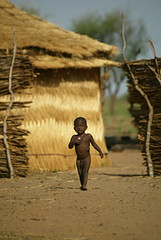 After months of repeated pleas from the United Nations, international aid began in July to pour into this vast arid and semi-arid and landlocked West African nation, ranked by the United Nations to be the second poorest in the world. Niger is now at the biggest impact of last year’s reduced grain, pasture and fodder yields, brought about by the biggest locust invasion of the last 15 years followed by a premature end to the rainy season. Crop and livestock farmers in Maradi, Tillabery, Zinder, and Tahoua – four departments bordering Nigeria in the south – are suffering the most. In villages here, household granaries and fodder stocks are low or empty, cereal prices are skyrocketing (they are now 75-80 percent above the average for the last five years), and livestock prices are plummeting (the cereal purchasing power for livestock-dependent households in agro-pastoral zones is only 25 percent of what it was a year ago).
After months of repeated pleas from the United Nations, international aid began in July to pour into this vast arid and semi-arid and landlocked West African nation, ranked by the United Nations to be the second poorest in the world. Niger is now at the biggest impact of last year’s reduced grain, pasture and fodder yields, brought about by the biggest locust invasion of the last 15 years followed by a premature end to the rainy season. Crop and livestock farmers in Maradi, Tillabery, Zinder, and Tahoua – four departments bordering Nigeria in the south – are suffering the most. In villages here, household granaries and fodder stocks are low or empty, cereal prices are skyrocketing (they are now 75-80 percent above the average for the last five years), and livestock prices are plummeting (the cereal purchasing power for livestock-dependent households in agro-pastoral zones is only 25 percent of what it was a year ago).
Populations have migrated out of the most vulnerable zones and are consuming wild food. One child out of five under the age of five is moderately malnourished and at risk of becoming severely so in the near future if not assisted. Moderate malnutrition is estimated between 13.4 and 19.4 percent, severe malnutrition between 2.4 and 2.9 percent in the most severely affected areas, with rates similar to those of the worst conflict zones and emergencies in the world. As many as 150,000 under 5-year-old children are affected by severe malnutrition among the estimated 800,000 malnourished children nationwide.
Jan Egeland, the UN Emergency Relief Coordinator, told reporters in July that several thousand children had undoubtedly perished this year for lack of food. An April 2005 joint food security assessment by the Niger Government, the Food and Agriculture Organization of the United Nations (FAO), WFP and FEWS NET estimated that 2.4 million of the 3.6 million people living in agropastoral areas were highly vulnerable to food insecurity. Of those, 1.2 million were judged to require some level of food aid. The latest estimate is that 874,000 persons face extreme food insecurity conditions and need free food. This number could grow in the next six weeks as pastoralists return north with their remaining livestock.
Although some press reports indicate that from 150,000 infants to 3.5 million people are threatened by starvation in Niger, FEWS NET argues that there is no basis to expect that starvation is a likely outcome for these numbers of infants or people. ‘Children will likely die from malnourishment but a substantial proportion is probably dying from conditions related to poor water quality, or other non-food related problems.’ FEWS NET reports that although the current food security crisis in Niger is serious, it affects far fewer people than current crises in Ethiopia, Somalia, Zimbabwe and Sudan (Darfur and Northern Bahr El Gazal). The situation in Niger is on par with that found in eastern Chad (in both the refugee camps and among local populations near the camps), and much more severe than those currently found in Mali and Mauritania.
The Hunger Season 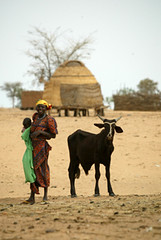 Hunger is an annual event in Niger, where some 82 percent of the population rely on subsistence farming and cattle rearing and only 15 percent of the land is suitable for arable farming. Beyond a little irrigation along the Niger River, most farmers are at the mercy of the rains. Food shortages lasting several months are nothing new. The annual hunger season starts after the millet is planted, at the beginning of the rains in June, and lasts through October, when it’s harvested. Last year’s double whammy of a locust plague followed by poor rains reduced not only millet harvests but also pastures, which feed the country’s livestock, the lifeblood of Niger’s farmers as well as herders. So the hunger season this year has been longer and more intense than normal, putting many people, along with their livelihoods and livestock, over the edge. Niger’s nutritional crisis is likely to deepen still further in the run up to the next harvest. Rural households traditionally help close the annual hunger gap by selling a few animals to buy enough grain to survive until the next millet harvest, in October. This strategy is not working this year. Too many animals are flooding the market, sending livestock prices down, and rising prices for scarce local grain are beyond the reach of poor farmers surviving on less than US$1 a day. Farm households have exported their young men to work as far away as Libya and Algeria and nomads are competing with farmers for scarce resources as they move their herds around looking for fodder. FEWS NET has published the following crisis indicators about the crisis in Niger:
Hunger is an annual event in Niger, where some 82 percent of the population rely on subsistence farming and cattle rearing and only 15 percent of the land is suitable for arable farming. Beyond a little irrigation along the Niger River, most farmers are at the mercy of the rains. Food shortages lasting several months are nothing new. The annual hunger season starts after the millet is planted, at the beginning of the rains in June, and lasts through October, when it’s harvested. Last year’s double whammy of a locust plague followed by poor rains reduced not only millet harvests but also pastures, which feed the country’s livestock, the lifeblood of Niger’s farmers as well as herders. So the hunger season this year has been longer and more intense than normal, putting many people, along with their livelihoods and livestock, over the edge. Niger’s nutritional crisis is likely to deepen still further in the run up to the next harvest. Rural households traditionally help close the annual hunger gap by selling a few animals to buy enough grain to survive until the next millet harvest, in October. This strategy is not working this year. Too many animals are flooding the market, sending livestock prices down, and rising prices for scarce local grain are beyond the reach of poor farmers surviving on less than US$1 a day. Farm households have exported their young men to work as far away as Libya and Algeria and nomads are competing with farmers for scarce resources as they move their herds around looking for fodder. FEWS NET has published the following crisis indicators about the crisis in Niger:
- Unprecedented high food prices.
- Scarcity of local foodstuffs.
- Scarcity of animal feed.
- Collapse of livestock prices.
- Exodus/migration of entire households to neighboring countries in search of new employment.
- Accelerated use of unsustainable survival strategies, liquidation of livestock, household assets and excessive felling of trees in fragile environments.
- Malnutrition rates continue to climb.
The Bad News/Good News
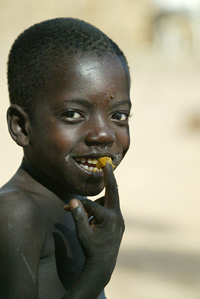 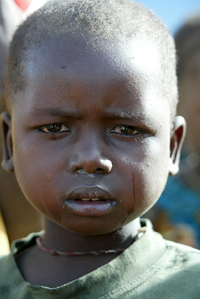
|
The bad news is that in the short-term, malnutrition rates, especially for children, are likely to continue to deteriorate, even if this year’s rains continue to be good. Admissions are rising at therapeutic feeding centres and it is estimated that fewer than one malnourished person in ten makes it to one of the centres. In addition, the rainy season increases the prevalence of malaria and diarrhoeal diseases, which typically increase the risk of severe malnutrition among children. The UN Office for the Coordination of Humanitarian Affairs (OCHA) in July doubled its Niger appeal and warned that it would soon raise it again. Less publicized food crises await to be properly addressed in other countries of the Sahel, the semi-arid strip south of the Sahara desert, such as Mali, Mauritania and Burkina Faso.
The good news is that the current rainy season has gotten off to a very good start in Niger. FEWS NET reports that farmers have been able to plant early; according to the Niger Government’s estimates, 92 percent of the area expected to be under cultivation had been planted by June 15 compared to the 65 percent that is normal for this time of year. The favourable rains are improving pastures, although animal conditions will not rebound immediately. FEWS NET reports that cereal prices in other parts of the Sahel are beginning to fall and those in Niger will likely do the same. Prices for livestock should soon improve with good pasture conditions. The maize harvest is underway in Nigeria, Benin, Ghana, and Ivory Coast, and supplies of imported maize from those countries should soon be arriving in Niger. This will bring lower overall cereal prices.
The national body in Niger in charge of coordinating risk reduction, prevention and response activities to mitigate and manage food crises (Dispositif National de Prévention et de Gestion des Crises Alimentaires – DNPGCA and Cellule Crise Alimentaire of the Prime Minister’s Cabinet – CCA) has so far promoted subsidized sales, cereal banks, food for work and loans of cereals to be reimbursed after the upcoming harvest in October. Since mid-July, the Government has been distributing free food to specific targets in the most critical areas while continuing to subsidize sales in less critical areas. New partners are settling in Niger and/or boosting their capacities: French Red Cross, Spanish Red Cross, Norwegian Red Cross, Qatari Red Crescent, IFRC, Save the Children US, Islamic Relief, Oxfam UK, Concern, Réunir, MSF/Switzerland. Development partners are stretching their ongoing programs to emergency response activities: World Vision, Care, Africare, CRS, Caritas, Oxfam Québec. These Christian, Muslim and secular humanitarian actors are implementing a range of activities in the most affected area of Niger’s southern agro-pastoral zone, where most of the population is concentrated, with the objective to save lives, to protect agricultural production tools/livelihoods and livestock and to promote the 2005 agricultural campaign.
Immediate Needs  FEWS NET recommends the main focus of additional, immediate, assistance be:
FEWS NET recommends the main focus of additional, immediate, assistance be:
- an augmentation of supplemental feeding for children under five;
- additional support for Niger’s free food distributions;
- provision of emergency animal fodder and livestock nutritional supplements;
- assistance with sanitation and potable water (in areas with the highest malnutrition); and
- seeds for second season cropping, especially short cycle beans.
On 4 August, the UN raised its emergency flash appeal to almost $81 million and the WFP reported that if assistance were not provided quickly, it expects to see a massive liquidation of property and livestock with a severe impact on the current agricultural season.
Long-term Needs
Emergency assistance is not enough. More research and development resources should be spent to address Niger’s chronic food insecurity. Observers say projects aiming to address the root cause of the food crisis, which is poverty, are being diverted to support emergency efforts when the situation calls for close links between relief, development and research activities. Only such links will ensure that humanitarian programs do not inhibit longer term research and development efforts from addressing the underlying causes of poverty. Serious analysis shows that hunger can be conquered and at a modest cost compared to the benefits. The case for making agriculture a priority sector for aid to Niger – where agricultural production accounts for 39 percent of GDP – is overwhelming. ‘The least funding so far is for agricultural programmes’, Jan Egeland has said, ‘which I regret because those are the programmes that can get people out of this,’ explaining that people are now slaughtering or selling their cattle used for breeding.
The case for supporting livestock development in Niger – where livestock products make up one of just two main exports and 82 percent of the population practice agro-pastoral subsistence farming – is also overwhelming. ‘The hunger crisis in Niger is difficult to assess because it is “patchy”,’ says Bruno Gerard, an ILRI partner scientist based outside Niamey and working for the last 14 years working for ILRI’s sister institute, the International Crops Research Institute for the Semi-Arid Tropics (ICRISAT). ‘That and other issues that must be addressed to resolve Niger’s chronic food insecurity are largely researchable issues,’ he says. Gerard manages a large project with 10 partners building research-based ‘decision-support systems’ to help farmers improve their marketing, soil fertility and other strategies. ‘This is not a hopeless country’, says Gerard. ‘Traditional options are simply not working well. The real opportunities here are in finding ways to intensify the traditional mixed crop-and-livestock farming systems for greater productivity and sustainability. And that’s just what we’re doing with ILRI and other scientific partners.’
The Livestock Crisis 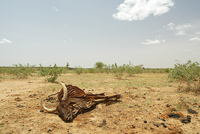 Nomadic herdsmen, whose starving cattle and donkeys have begun dying in large numbers, are at even greater risk than crop farmers. Humanitarian workers reckon it will take them at least two years to rebuild their herds. The limited availability of pasture and of fodder is endangering livestock. Niger’s fodder deficit in pastoral areas in 2004 was 154 percent greater than the 2000 deficit, and at 4.6 tons, the largest fodder deficit in Niger’s history. One-third of this deficit was caused by locusts and two-thirds by the 2004 drought. Fodder remains very expensive. Cows, sheep, goats and camels, which represent the ‘saving accounts’ of agro-pastoralists and pastoralists, are typically meagre and are being sold at dramatically low prices. The monetary value of livestock compared to the equivalent in cereals has decreased between 42 and 55 percent. High cereal prices and falling animal prices in the most affected pastoral and agro-pastoral areas, have led to some households having to liquidate assets in the face of these harsh terms of trade.
Nomadic herdsmen, whose starving cattle and donkeys have begun dying in large numbers, are at even greater risk than crop farmers. Humanitarian workers reckon it will take them at least two years to rebuild their herds. The limited availability of pasture and of fodder is endangering livestock. Niger’s fodder deficit in pastoral areas in 2004 was 154 percent greater than the 2000 deficit, and at 4.6 tons, the largest fodder deficit in Niger’s history. One-third of this deficit was caused by locusts and two-thirds by the 2004 drought. Fodder remains very expensive. Cows, sheep, goats and camels, which represent the ‘saving accounts’ of agro-pastoralists and pastoralists, are typically meagre and are being sold at dramatically low prices. The monetary value of livestock compared to the equivalent in cereals has decreased between 42 and 55 percent. High cereal prices and falling animal prices in the most affected pastoral and agro-pastoral areas, have led to some households having to liquidate assets in the face of these harsh terms of trade.
In worst cases, cows are being sold for US$10. Dakoro, Filingué and Ouallam are the worst affected zones for livestock. Pastoralists and agro-pastoralists began moving their animals south towards the coast earlier than normal to graze on the residue of harvested crops. While this preserves the herds, pastoralist households, especially women and children who normally remain in Niger, will be longer without meat and milk from their animals, and will have to buy more of their food by selling small animals, their assets, or their labor. This also results in larger numbers of males migrating to seek paid labour. This year's return of livestock herds from the south began with the good rains that started in May and June. There have been cases where some herds were temporarily ‘stranded’ between their northern pastures that had yet to regenerate, and the areas they were leaving in order for planting to begin. It is also noted that this year, coping capacities appear to be stretched to the limit by continuing high cereal prices that translate into poor terms of trade in selling livestock to buy cereals.
-Source: FEWS NET
ILRI and Livestock Research in Niger
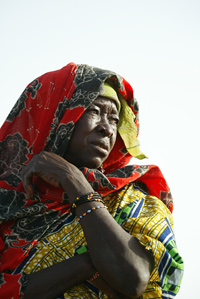
|
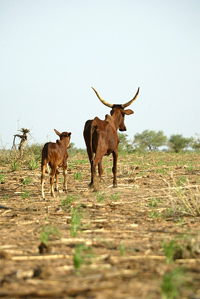
|
ILRI has conducted livestock research for development in Niger for three decades. ILRI’s senior scientists in the country have included (in chronological order) geographer and anthropologist Matt Turner (USA), rangeland ecologist Pierre Hiernaux (France), soil scientist Mark Powell (USA), agricultural economist Tim Williams (Nigeria), animal nutritionist Salvador Fernández-Rivera (Mexico), and livestock systems specialist Augustine Ayantunde (Nigeria), the latter leads ILRI research in Niger today. Among the Nigerian support team that have worked for ILRI over these years are two technicians who have lived and worked for 15 years in ILRI’s two target villages in Fakara, an area between the Niger Valley and the Dallol Bosso, one hundred km east of Niger’s capital, Niamey. ILRI work in Fakara covers a region of over 500 sq km. Most of the images in this photo essay were obtained in Fakara in June 2005, one month before the country's hunger problem began to make news.
ILRI’s long-term focus in Niger is finding improved ways to integrate livestock keeping into crop farming systems to improve the Sahel’s fragile lands as well as the livelihoods of its peoples. ILRI (www.ilri.org) has conducted much of its research in Niger under the aegis of two systemwide programs of the Consultative Group on International Agricultural Research (www.cgiar.org), which sponsors the research of ILRI and 14 other centres working to alleviate poverty in the developing world: the ILRI-convened Systemwide Livestock Programme (www.vslp.org/vslp/front_content.php) and the ICRISAT-convened Desert Margins Program (www.icrisat.org/text/partnerships/dmp/dmp.htm). In these and other projects, ILRI focuses on livestock aspects and ICRISAT on food and feed crops which, taken together, can refine the integration of crop and livestock production with triple-bottom-line benefits for people (more food), livestock (more feed) and soils (more nutrients).
ILRI’s Niger team recently conducted a project funded by USAID investigating how to improve markets for small-scale peri-urban farmers producing milk and fattening sheep (for Muslim holidays) and collaborated with America’s Wisconsin University on research to help manage conflicts between crop and livestock producers. In the scorching hot and resource-challenged Sahelian environments, where transhumance is practised as it has been for millennia, and where millet and livestock mean life and livelihood to most of the population, conflicts over increasingly scarce water and land resources are increasing.
Livestock Relief 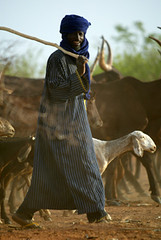 FAO renewed on 2 August its appeal for $4 million urgently needed for veterinary services and to feed livestock, which play a key role in the livelihoods and food security of many of the most vulnerable households. ‘Livestock are crucial to agro-pastoralist families in Niger, for income as well as food,’ the Chief of FAO’s Emergency Operations Service, Fernanda Guerrieri, said. ‘The sale of livestock is often a measure of last resort, after families have already consumed all of their cereal stocks and require cash to buy food for the lean period before the next harvest. A loss of livestock or decrease in their market value can have a devastating impact on these families’ food security,’ she added. Livestock aid is needed for more than 10,000 families who have lost their animals. Without this assistance, the crisis could worsen and more food aid would be needed. The funds will be used to provide veterinary services and feed for more than 10,000 families facing severe hunger due to livestock losses.
FAO renewed on 2 August its appeal for $4 million urgently needed for veterinary services and to feed livestock, which play a key role in the livelihoods and food security of many of the most vulnerable households. ‘Livestock are crucial to agro-pastoralist families in Niger, for income as well as food,’ the Chief of FAO’s Emergency Operations Service, Fernanda Guerrieri, said. ‘The sale of livestock is often a measure of last resort, after families have already consumed all of their cereal stocks and require cash to buy food for the lean period before the next harvest. A loss of livestock or decrease in their market value can have a devastating impact on these families’ food security,’ she added. Livestock aid is needed for more than 10,000 families who have lost their animals. Without this assistance, the crisis could worsen and more food aid would be needed. The funds will be used to provide veterinary services and feed for more than 10,000 families facing severe hunger due to livestock losses. 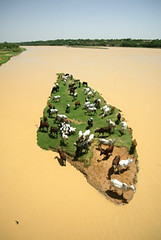
Oxfam is helping 28,000 people by buying, for a fair price, cattle too emaciated for herders to sell. Cattle prices have been plummeting and are now 90 percent lower than they were before the crisis. Even healthy animals are fetching only a fraction of their former value. A strong bull that once went for more than $500 now sells for as little as $18. ‘Oxfam’s response is stimulating the economy by trying to use local markets,’ said Mike Delaney, Oxfam America’s director of humanitarian response. Another voucher-for-work project is linked to the cattle-buying program. Oxfam has already purchased 1,000 cows from local breeders for about $53 a head, providing people with money to feed both their families and their remaining animals. Oxfam then has the cows slaughtered in the villages and inspected by veterinarians to make sure the meat is fit for consumption. Women involved in the voucher-for-work program dry or fry the meat. Oxfam gives some of the meat to them in exchange for their work, or distributes it through the rest of the voucher program.
Bitter Ironies 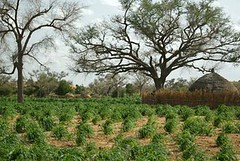 Newcomers heading into Niger’s countryside find it surprisingly green. Aside from pockets of dusty scrub, healthy young foot-tall millet crops appear from one horizon to the other. Herein lies a bitter paradox. The rainy season, which gets into full swing in August, actually started well this year, in June. But this does nothing to fill the so-called hunger gap between the June planting and October harvesting. Crops may be growing, but they are of no use to anyone for another two months. New grass sprouting from sandy rangelands is just as useless to the ubiquitous herds of cattle and donkeys, for many of which the young shoots are too little too late; the animals lie down on the new green pastures and don’t get up again. Things appear deceptively fine even in the mud hut villages – where the women pound millet and the children run and play – until one takes a closer look or pays a visit to the women’s huts where the ‘silent hunger’, as its being called, has struck young children, making them too weak or ill to cry.
Newcomers heading into Niger’s countryside find it surprisingly green. Aside from pockets of dusty scrub, healthy young foot-tall millet crops appear from one horizon to the other. Herein lies a bitter paradox. The rainy season, which gets into full swing in August, actually started well this year, in June. But this does nothing to fill the so-called hunger gap between the June planting and October harvesting. Crops may be growing, but they are of no use to anyone for another two months. New grass sprouting from sandy rangelands is just as useless to the ubiquitous herds of cattle and donkeys, for many of which the young shoots are too little too late; the animals lie down on the new green pastures and don’t get up again. Things appear deceptively fine even in the mud hut villages – where the women pound millet and the children run and play – until one takes a closer look or pays a visit to the women’s huts where the ‘silent hunger’, as its being called, has struck young children, making them too weak or ill to cry.
Many villagers say they can’t afford to leave their families to take a famished child to the nearest feeding centre. They are busy ploughing and preparing their land for the next crop that will feed their household for the coming year. Even when sick, many people won’t come for treatment because they’re frightened to leave the young crops that they’re trying to nurse into life. It is a deathly bind. Top United Nations aid official Jan Egeland and aid officials have accused the international community of reacting slowly to the crisis in Niger, which was widely predicted after last year's poor harvests, and further say the slow response has greatly increased the cost of dealing with the crisis. When the first appeal was made, only $1 per day, per person would have helped solve the food crisis, the U.N. has said. Now that the situation has worsened and people are weaker, $80 will be needed per person. One reason for the delay in international response was that other events were crowding out news about the hunger in major media.
Following the worst turmoil in Darfur and the tsunami in Southeast Asia, ironically it was the G8 summit in Gleneagles, Scotland, in June, with the rock-star Live8 concerts and ‘Make Poverty History’ campaigns that attended it, that helped push the Niger crisis off world headlines. While the G8 was noisily canceling the debts of Niger and 13 other African countries, this club of the world’s most powerful nations failed to notice or even mention Niger’s hunger crisis.
The Cereal Crisis 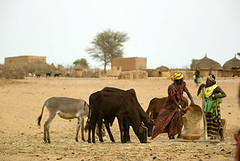 As local cereals (millet, sorghum) have become scarce items on the market in Niger and the subregion as well as subject to speculation, prices have doubled over normal. Most warehouses are empty. Assessments undertaken by CILSS (the regional inter-governmental body responsible for Sahelian food security) found that unusually high prices for millet and sorghum in neighboring markets in Nigeria, Ghana, Benin and Ivory Coast have been drawing Sahelian grain to the south during the last few months. Outflow from Niger has been significant and a major factor in driving up prices in the agro-pastoral and pastoral zones of Niger where purchasing power is the weakest. In most years, Niger imports cereals from surplus-producing areas of its neighbors in Nigeria, Burkina Faso, and Mali. However, this year, each of these three countries imposed restrictions of exports, due to fears of famine and grain shortages, despite trade treaties that forbid that. CILSS has cautioned that overstatements of the severity of Sahelian food crises by the media, international agencies, and NGOs have had the unintended consequence of causing private traders to withhold stocks from the market, in anticipation of higher prices, or of local purchases by aid agencies, further pushing up cereal prices.
As local cereals (millet, sorghum) have become scarce items on the market in Niger and the subregion as well as subject to speculation, prices have doubled over normal. Most warehouses are empty. Assessments undertaken by CILSS (the regional inter-governmental body responsible for Sahelian food security) found that unusually high prices for millet and sorghum in neighboring markets in Nigeria, Ghana, Benin and Ivory Coast have been drawing Sahelian grain to the south during the last few months. Outflow from Niger has been significant and a major factor in driving up prices in the agro-pastoral and pastoral zones of Niger where purchasing power is the weakest. In most years, Niger imports cereals from surplus-producing areas of its neighbors in Nigeria, Burkina Faso, and Mali. However, this year, each of these three countries imposed restrictions of exports, due to fears of famine and grain shortages, despite trade treaties that forbid that. CILSS has cautioned that overstatements of the severity of Sahelian food crises by the media, international agencies, and NGOs have had the unintended consequence of causing private traders to withhold stocks from the market, in anticipation of higher prices, or of local purchases by aid agencies, further pushing up cereal prices.
These issues merit further study.  West African grain markets are generally working very well, perhaps too well. The high cereal price levels found in the Sahel are being driven by strong demand for Sahelian cereal production, and greater purchasing power in coastal West African countries. Markets in the most food-insecure zones in the Sahel (and in Niger) usually have higher cereal prices than elsewhere, due to the high costs of transporting grain to these sparsely-populated and poor areas. Although their governments are committed to open markets, high costs and infrastructure limitations do not allow Sahelian markets to efficiently collect surpluses, anticipate local and regional demand conditions, and supply foods to poor households at affordable prices. Source: FEWS NET
West African grain markets are generally working very well, perhaps too well. The high cereal price levels found in the Sahel are being driven by strong demand for Sahelian cereal production, and greater purchasing power in coastal West African countries. Markets in the most food-insecure zones in the Sahel (and in Niger) usually have higher cereal prices than elsewhere, due to the high costs of transporting grain to these sparsely-populated and poor areas. Although their governments are committed to open markets, high costs and infrastructure limitations do not allow Sahelian markets to efficiently collect surpluses, anticipate local and regional demand conditions, and supply foods to poor households at affordable prices. Source: FEWS NET
ILRI, Livestock and the Millennium Development Goals 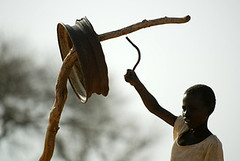 The international community is laying the groundwork for a new, coherent and eminently feasible attack on global poverty. The focus of this effort is the Millennium Development Goals (MDG) – eight commitments drawn from the Millennium Declaration, endorsed by all member states of the United Nations in September 2000. Ranging from halving extreme poverty to halting the spread of HIV/AIDS and providing universal primary education – all by the target date of 2015 – they represent a set of simple but powerful objectives that every man and woman in the street, from New York to Nairobi to New Delhi, can easily understand and support. . . . The MDG are people-centred, time-bound and measurable. . . . Now we have a set of clear, measurable indicators, focused on basic human needs, that can provide clear benchmarks of progress – or the lack of it – both globally and on a country-by-country basis. . . . Never before have such concrete goals been formally endorsed by rich and poor countries alike. And never before have the UN, the World Bank, the International Monetary Fund and all the other principal arms of the international system come together behind the same set of development objectives. . . . And the MDG are achievable. – Source: Kofi Annan, Economist: The World in 2003
The international community is laying the groundwork for a new, coherent and eminently feasible attack on global poverty. The focus of this effort is the Millennium Development Goals (MDG) – eight commitments drawn from the Millennium Declaration, endorsed by all member states of the United Nations in September 2000. Ranging from halving extreme poverty to halting the spread of HIV/AIDS and providing universal primary education – all by the target date of 2015 – they represent a set of simple but powerful objectives that every man and woman in the street, from New York to Nairobi to New Delhi, can easily understand and support. . . . The MDG are people-centred, time-bound and measurable. . . . Now we have a set of clear, measurable indicators, focused on basic human needs, that can provide clear benchmarks of progress – or the lack of it – both globally and on a country-by-country basis. . . . Never before have such concrete goals been formally endorsed by rich and poor countries alike. And never before have the UN, the World Bank, the International Monetary Fund and all the other principal arms of the international system come together behind the same set of development objectives. . . . And the MDG are achievable. – Source: Kofi Annan, Economist: The World in 2003
The knowledge and technologies generated by ILRI and its many partners in the North and South that are conducting livestock research for development are helping to meet the United Nations Millennium Development Goals. ILRI is a non-profit-making and non-governmental organization working at the crossroads of livestock and poverty. ILRI has its headquarters in Nairobi, Kenya, and a second principal campus in Addis Ababa, Ethiopia. The Institute belongs to the Consultative Group on International Agricultural Research (CGIAR). This association of more than 60 governments and organizations supports a network of 15 Future Harvest agricultural research centres working to reduce poverty, hunger and environmental degradation in developing countries. The co-sponsors of the CGIAR are the World Bank, the UNDP, FAO and the International Fund for Agricultural Development.
Increasing developing-country livestock trade without increasing disease
Are there opportunities for greater trade of livestock products from developing countries without increasing the risk of spreading animal diseases?
A new study from the International Livestock Research Institute (ILRI) and the Food and Agriculture Organization of the United Nations (FAO) suggests that there are and lays out a series of recommendations as to how they might be achieved. Livestock is one of the key assets of most developing countries, but compared to other agricultural products, this resource is currently significantly underutilised as a tool for poverty reduction. One of the reasons behind this is that many developing countries still harbour animal diseases that present a risk to the West, where diseases such as foot and mouth disease (FMD) and classical swine fever (CSF), to name but two, have been eradicated. Their reintroduction to countries free of these diseases has disastrous economic and environmental consequences. This dichotomy presents yet another example of the widening divide between developed and developing countries. So how can developing countries make better use of their livestock resources through greater market access in the world without putting developed countries at greater risk? This topic has been the subject of a study recently undertaken by ILRI on behalf of FAO, the report of which was released in July 2005.
Entitled ‘An appropriate level of risk: balancing the need for safe livestock products with fair market access for the poor’, the report questions some of the ground rules for safe international trade in livestock commodities, while at the same time identifying specific needs for human resource capacity development to safeguard the animal health and food safety integrity of livestock commodity value chains. Led by ILRI’s veterinary epidemiologist Brian Perry, the study identified some market successes, and some failures, in the regions of South East Asia, eastern and southern Africa and Central America, drawing from them some key lessons of global significance.
Read the complete report: http://www.fao.org/ag/againfo/programmes/en/pplpi/docarc/wp23.pdf
Livestock aid urgently needed for Niger families
Without livestock aid the crisis in Niger will worsen and more food and other aid will be needed. The Food and Agriculture Organization of the United Nations (FAO) issued an urgent appeal today for livestock aid for more than 10,000 Niger families who have lost their animals. It is estimated that 3.5 million – more than a third of Niger’s population – are experiencing chronic food shortages. Food crops have been decimated by drought and locusts, and millions of livestock have perished. Many of the poorest and most vulnerable families are dependent on livestock for food and income. Milk is particularly important for children’s nutrition. Now the rains have come, pasture is available, but many of the animals have died and any remaining livestock are in very poor condition, with little milk being produced. FAO is appealing for livestock, livestock feed and veterinary services to help Niger people rebuild their lives and livelihoods. 



